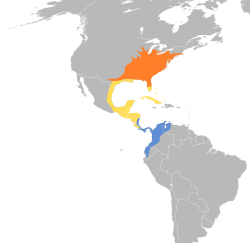Acadian flycatcher
| Acadian flycatcher | |
|---|---|

| |
| ⓘ | |
| Scientific classification | |
| Domain: | Eukaryota |
| Kingdom: | Animalia |
| Phylum: | Chordata |
| Class: | Aves |
| Order: | Passeriformes |
| Family: | Tyrannidae |
| Genus: | Empidonax |
| Species: | E. virescens
|
| Binomial name | |
| Empidonax virescens (Vieillot, 1818)
| |

| |
| Synonyms[2] | |
|
Platyrhynchos virescens Vieillot, 1818 | |
The Acadian flycatcher (Empidonax virescens) is a small insect-eating bird of the tyrant flycatcher family.
Description
[edit]Adults have olive upperparts, darker on the wings and tail, with whitish underparts; they have a white eye ring, white wing bars and a wide bill. The breast is washed with olive. The upper part of the bill is dark; the lower part is yellowish. This bird's song is an explosive peet-sa. The call is a soft peet. They also have a call similar to that of the northern flicker.[citation needed] A unique two-note song described as "ka-zeep" helps to identify this species.[3]
Measurements:[4]
- Length: 5.5–5.9 inches (14–15 cm)
- Weight: 0.4–0.5 ounces (11–14 g)
- Wingspan: 8.7–9.1 inches (22–23 cm)
Taxonomy
[edit]Originally described in 1810 by ornithologist Alexander Wilson, its first scientific name was Muscicapa querula.[5] The Acadian flycatcher is the only member of its clade within Empidonax, but is most closely related to willow and alder flycatchers.[6]
Distribution
[edit]Its breeding habitat is deciduous forests, often near water, across the eastern United States and southwestern Ontario. These birds migrate through eastern Mexico and the Caribbean to southern Central America and the very northwest of South America in Colombia, western Venezuela, and Ecuador.
The numbers of these birds have declined somewhat in the southern parts of their range. Brown-headed cowbirds lay eggs in the nests of these birds in some areas. However, only 16% of cowbird young in Acadian flycatcher nests fledge successfully.
They wait on a perch in the middle of a tree and fly out to catch insects in flight (hawking), also sometimes picking insects from foliage while hovering (gleaning). They may eat some berries and seeds.
They make a loose, shallow nest in a horizontal forks of trees and shrubs, primarily in lowland forests and marshy areas.[7]
The Acadian flycatcher is an excellent flier; it is extremely maneuverable, can hover, and can even fly backward. Curiously, there is no scientific information on hopping or walking by this bird.[8]
As of October 2015 there have been 2 records of Acadian flycatcher in Europe, the first being a bird found dead in Iceland in 1967,[9] and the second a bird found on the beach at Dungeness in Kent, England in September 2015,[10] the latter's identity being established by DNA from its droppings.[11]
References
[edit]- ^ BirdLife International (2016). "Empidonax virescens". IUCN Red List of Threatened Species. 2016: e.T22699842A93750963. doi:10.2305/IUCN.UK.2016-3.RLTS.T22699842A93750963.en. Retrieved 12 November 2021.
- ^ "Empidonax virescens (Vieillot, 1818)". Global Biodiversity Information Facility. Retrieved 21 May 2023.
- ^ "Species Profile (Acadian Flycatcher)". Species at Risk Public Registry. Government of Canada. Archived from the original on 12 June 2017. Retrieved 19 June 2017.
- ^ "Acadian Flycatcher Identification, All About Birds, Cornell Lab of Ornithology". www.allaboutbirds.org. Retrieved 2020-09-27.
- ^ Allen, M. C., M. M. Napoli, J. Sheehan, T. L. Master, P. Pyle, D. R. Whitehead, and T. Taylor (2020). Acadian Flycatcher (Empidonax virescens), version 1.0. In Birds of the World (P. G. Rodewald, Editor). Cornell Lab of Ornithology, Ithaca, NY, USA. https://doi.org/10.2173/bow.acafly.01
- ^ Johnson, N.K.; Cicero, C. (2002). "The role of ecologic diversification in sibling speciation of Empidonax flycatchers (Tyrannidae): multigene evidence from mtDNA". Molecular Ecology. 11: 2065–2081. doi:10.1046/j.1365-294X.2002.01588.x.
- ^ Ford, E.R.; Howell, Arthur H. (1926). "Two comments on the nidification of the Acadian flycatcher". Wilson Bulletin. 38 (4).
- ^ Whitehead, Donald R. and Terry Taylor. (2002). Acadian Flycatcher (Empidonax virescens) The Birds of North America Online (A. Poole, Ed.). Ithaca: Cornell Lab of Ornithology; Retrieved from the Birds of North America Online (subscription required). doi:10.2173/bna.614
- ^ "MEGA – Acadian Flycatcher at Dungeness". The Nature Quest blog. 22 September 2015. Retrieved 19 June 2017.
- ^ "Rare North American bird arrives on British shores for the first time". Daily Telegraph. 23 September 2015. Retrieved 19 June 2017.
- ^ "Acadian Flycatcher and Chestnut Bunting added to BOU's British list". BirdGuides.com. 12 December 2016. Retrieved 19 June 2017.
External links
[edit]- Acadian flycatcher – Empidonax virescens USGS Patuxent Bird Identification InfoCenter
- Acadian flycatcher Species Account – Cornell Lab of Ornithology
- Acadian flycatcher videos on the Internet Bird Collection
- Acadian flycatcher photo gallery VIREO Photo-High Res--(Close-up)

